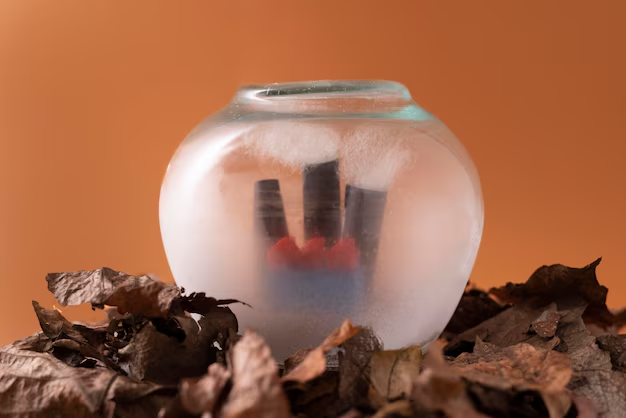
Archaeologists claim that a 4,000-year-old vial of ancient red lipstick
Photo Credit (Freepik)
According to a February study published in the journal Scientific Reports, the uncommon discovery is “probably the earliest” instance of lipstick to be examined and documented scientifically.
Hematite and other minerals that generate a rich red color comprised over 80% of the tested sample. Along with traces of other minerals and waxy materials derived from vegetables and other organic materials, the mixture also included the dark-colored minerals braunite and manganite.
The study’s authors observed that “the waxy substances and the intensity of the red coloring minerals are, surprisingly enough, fully compatible with recipes for contemporary lipsticks.”
Lead study author Massimo Vidale, an archaeologist at the Department of Cultural Heritage at the University of Padua in Italy, said it is impossible to rule out the idea that the cosmetic was used in other contexts, such as as blusher. However, he claimed that the vial’s shape, the compounds it contained, and its uniform, deep red hue “suggested to us it was used on lips.”
Although it was unclear why lipstick-like cosmetic preparations were rare in the archaeological record, he said it’s one of the first examples of an old red cosmetic to be examined.
At this time, we don’t know. While a number of lighter-colored foundations and eye shadows had previously been reported, the deep red color we discovered was the first one we encountered,” he stated in an email.
Joann Fletcher, a professor in the archaeology department at the University of York, claims that the use of hematite, or crushed red ocher, has been recorded on stone cosmetic palettes from the late Neolithic and in ancient Egyptian cosmetic jars. It “all comes down to what this new discovery was actually used for,” she said, regardless of whether the Iranian vial was the first lipstick.
The contents of the vial might have been used as lip color. However, even though the vial resembles a contemporary lipstick tube, they could have also been used to color the cheeks or for another reason, according to an email from Fletcher, who was not involved in the study.
Laurence Totelin, an ancient history professor at Cardiff University’s School of History, Archaeology, and Religion who specializes in Greek and Roman science, technology, and medicine, stated that it is “very plausible” that the artifact was a lipstick.
The writers note that there are similarities between the recipe and a contemporary one. In an email, Totelin, who was not a participant in the study, stated, “The deep red color is also what we would expect for lip makeup.”
According to Totelin, “the vial has a shape that is not inconsistent with a pharmaceutical use, and the ingredients are also regularly found in the preparation of ancient medicines.”
Artifacts are exposed by floods.
Archaeologists have previously examined black kohl eyeliners and lighter-colored substances used as foundation or eye shadows, among other items discovered in Egypt and the Middle East. The mixture in the vial contained less lead than other antiquated cosmetics. The researchers hypothesized that this low amount would indicate that the lipstick’s creators were aware of the risks associated with eating lead, a naturally occurring hazardous element that can result in a host of health issues.
“The toxicity of lead compounds in cosmetics is a topic of intense and protracted discussion among experts,” Vidale stated.
According to earlier studies on artifacts from the same area that Vidale worked with, “our deep red preparation, supposedly meant for lips, was almost lead-free, while white lead was the base material for facial foundations 5,000 years ago.” “It could have been a deliberate decision,” he remarked.
The preparation included quartz particles from crystal or pulverized sand that were possibly used as a “shimmery-glittering agent,” according to the study. However, it’s also likely that the particles originated inside the vial, which was expertly made from a greenish stone known as chlorite.
Additionally, it’s unclear if the cosmetic’s initial consistency was fluid or more solid, according to Vidale.
The study’s authors noted an ancient Egyptian papyrus from the 12th century BC that shows a young woman painting her lips in this manner as an example. “The vial’s slender shape and limited thickness suggest that it could have been conveniently held in one hand together with the handle of a copper/bronze mirror, leaving the other hand free to use a brush or another kind of applicator,” the authors wrote.
The piece was one of hundreds of artifacts discovered in Iranian tombs and burials from the Bronze Age in the Jiroft region. When a river flooded in 2001, the graves, which were a part of an ancient kingdom called Marhasi, were uncovered and dislodged. Locals then looted and sold the graves’ priceless contents. Iranian security forces then found the vial along with numerous other copper and stone artifacts.
The researchers collected samples at Jiroft’s National Archaeological Museum, which houses the vial.
This civilization was uncovered “like a bolt out of the blue… when a disastrous flood hit its ancient cemeteries, exposing all kinds of archaeological treasures,” according to Vidale.
“The area is now well protected, but significant harm was done,” he continued. We now know that this was a highly developed civilization that resembled Mesopotamia, utilized its own writing system, was dominated by big towns and strong, autocratic leaders, and was a significant participant in long-distance trade and military expeditions. The remainder is gradually coming out of fresh excavations.
Who would have worn the lipstick and under what circumstances are unclear. According to Vidale, “as far as we know, cosmetics were regularly deposited near the deceased’s face in the graves of the time.”
Researchers haven’t been able to connect the artifact to particular human remains, though, because of the tombs’ theft and devastation.


